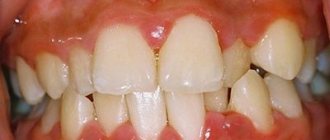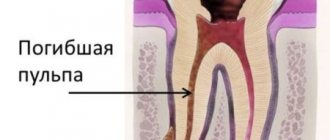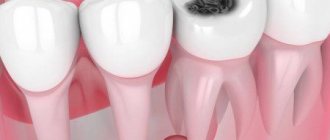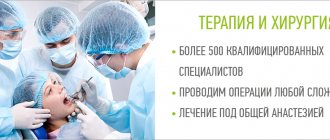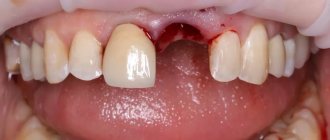If your teeth are not treated in time, unpleasant and dangerous consequences arise. In 50% of cases, the complication of caries turns into inflammation of the pulp or periodontitis. The latter, if not treated in a timely manner, takes a chronic course.
Chronic periodontitis is a pathology with a protracted inflammatory nature, located in the periapical area, in which destruction of dental tissue occurs. This disease leads to damage to the connecting elements that hold the tooth, resorption of the alveolar plate and bone tissue. In most cases, the disease attacks people over 50 years of age.
Chronic forms of periodontitis
This disease has virtually no symptoms. Signs appear if there is an exacerbation of the disease as a result of colds and hypothermia.
It is customary to distinguish three forms of this anomaly:
Chronic fibrous periodontitis
With this form, the fibrous part of the periodontium is transformed into fibrous ligaments. Symptoms of the disease are almost absent, as well as painful sensations.
Chronic fibrous periodontitis is diagnosed only with an x-ray. Normally, periodontitis looks like a narrow, even strip that divides the root and alveolus of the bone. The fibrous form is characterized by an enlarged gap in the periodontal area.
Chronic granulating periodontitis
The most aggressive form, which is expressed as loose red tissue at the apex of the root. It grows quickly and also quickly destroys bone, transforming it into a granulation substance.
The patient is bothered by aching pain, there is pain when biting a tooth, and a fistula often occurs on the gum.
In the picture, chronic granulating periodontitis has bright features. At the top of the root there are darkened areas that confirm the breakdown of bone tissue, in the place of which granulation tissue has already arisen.
Chronic granulomatous periodontitis
Externally, the disease manifests itself as a piece of mucous membrane in the form of a sac, which is called a “periodontal abscess.” There is pus inside the sac. Depending on the size, there are three types of this form:
- Less than a centimeter is a granuloma.
- From half a centimeter to 1 cm – cystogranuloma.
- More than a centimeter is a cyst.
At the onset of the disease, there are often no symptoms. As the dental system is attacked, the sensations when biting or tapping on a tooth increase.
In the picture, chronic granulomatous periodontitis is determined by a darkened area at the top of the root, which has an even outline in the form of a circle. It was in this place that the resorption of the bone tissue occurred.
Chronic apical periodontitis
Also asymptomatic. The patient begins to suspect a problem when the pulp has already reached the stage of necrosis, the color of the tooth has changed, and there is discomfort when chewing. Chronic apical periodontitis is diagnosed exclusively with the help of an x-ray, which shows a noticeable expansion of the periodontal type gap at the top of the root.
Diagnosis of chronic apical periodontitis
Diagnosis of chronic apical periodontitis is similar to that in the case of acute apical periodontitis. This means we use basic and additional diagnostic methods.
The main ones include clarifying the patient’s complaints, medical history, probing, percussion, palpation and determining tooth mobility.
The patient’s complaints are most often absent, but they may complain of discomfort while eating when biting.
Probing is painless, palpation of the mucous membrane in the apical area is also painless. Percussion is weakly positive.
Additional special methods include determining the electrical excitability of the pulp (reduced to 200 μA), determining occlusion (the presence or absence of a traumatic factor), fistula tract, and temperature tests.
NB! We definitely do an X-ray examination.
Exacerbation of chronic periodontitis
At this stage, all symptoms resemble the acute form. There is sharp pain, swelling and growth of lymph nodes. Considering that a chronic disease leads to bone destruction, during an exacerbation there is a risk of exudate getting inside the jaw. There is a possibility of a fistula.
The patient feels weak, his body temperature rises, and complaints of feeling cold arise.
What exactly are the consequences if chronic periodontitis worsens?
- Violation of the integrity of a periodontal type abscess. In the case of granulomatous periodontitis, the inflammatory area has boundaries of strong fibrous tissue in the form of a bag of pus. Excessive load on the tooth negatively affects the infected lesion, which is at rest. As a result, the pressure increases and the capsule ruptures, and the infection goes beyond the limits, leading to an exacerbation.
- Improper drainage of purulent contents. With granulomatous and granulating forms, pus is continuously discharged. However, it successfully exits through a fistula or root canals, ending up in the area of caries. Thus, the patient does not feel discomfort. But when the exits are closed, the pus accumulates, bursts and becomes inflamed. Pain and swelling occur.
- Reduced protective properties of the body. As a result, all those factors that previously prevented periodontal infections from growing and developing no longer carry out their main protective function. The infection is spreading on a large scale.
Clinical manifestations
The disease progresses dynamically, and its short periods of remission alternate with exacerbations. Clinical manifestations include the following:
- mild pain;
- sensation of fullness in the diseased tooth;
- swelling of the gums.
During periods of exacerbation of granulating periodontitis, localized paroxysmal pain occurs, which intensifies under the influence of irritants (both mechanical and thermal). Slight tooth mobility may be observed, as well as sensitivity of the lymph nodes in the lower jaw.
The appearance of a fistula is accompanied by the growth of granulation tissue around its mouth. Due to the fact that the pus is removed through the fistula canal, the pain subsides and a period of remission begins again.
It is very important not to delay treatment of granulating periodontitis, since its complications can include diseases such as dental granuloma, cyst, osteomyelitis of the jaw, and sepsis.
The pathology occurs in a chronic form and periodically becomes aggravated, which often goes away on its own and the person feels relief. A visual examination reveals pastiness, hyperemia and swelling of the gums. During an exacerbation, upon palpation, the dentist discovers an infiltrate in the root area, touching which causes severe pain. If treatment is not started, the infiltrate will increase in size and a fistula will appear. A fistulous tract with the release of pus can form even on the neck or face, so the symptoms of granulating periodontitis resemble subcutaneous actinomycosis. Further, after the fistula ruptures and the pus comes out, relief occurs, but the person still experiences pain when chewing food or when exposed to heat.
Exacerbation of pathology can be determined by the following clinical manifestations:
- In the area of the inflamed tooth, the lymph nodes increase in size.
- The gums become soft and swollen.
- Touching the affected area causes severe pain.
- Eating hot food or drinks causes burning and pain.
- The periodontal ligament weakens, which leads to loosening of the tooth.
Indications
There are 5 indications for starting treatment for granulating periodontitis:
- Pain on tooth percussion.
- Deformation, destruction, darkening of the tooth.
- Damage to nerves by carious tissue.
- Formation of pale depressions when pressing on the gums.
- Destruction of dentin and bone tissue (detected by x-ray).
Contraindications
Contraindications to the operation are:
- Cardiovascular diseases.
- Mental and neurological disorders.
- Allergic reaction to anti-inflammatory drugs and antibiotics.
- Intolerance to anesthesia.
Indications for treatment
The following indications exist for conservative treatment:
- Periodontitis of acute and chronic forms of single-rooted teeth, when the periapical tissues have not undergone large-scale changes.
- Periodontitis of acute and chronic forms of multi-rooted teeth, subject to patency of the canals and the absence of an irreversible process in the periapical tissues.
How is periodontitis eliminated? Treatment of the disease at the chronic stage
Regardless of the form, the root cause must be addressed first. To do this, the doctor works in the main root canal and its branches, as well as in the periodontium itself. If exudate is present, it must be quickly released. At the end of treatment, the gap between the periodontium and the root canals is carefully sealed.
Causes of acute periodontitis
Among the main reasons for the development of acute periodontitis are:
- acute inflammation of the pulp that occurs against the background of teeth affected by caries; pulp and periodontal tissues are closely related;
- the use of arsenic for pulp devitalization, which provokes inflammation of the pulp tissue due to the toxic effect of the drug penetrating the periodontium;
- the use of strong antiseptics and various cauterizing agents that are injected into the root canal, which provokes inflammation in nearby tissues;
- entry of a large amount of filling material into the periodontal space.
Therapeutic treatment
Chronic periodontitis is often successfully treated with therapy. To do this, the carious area is prepared and the old filling is removed. Continuous treatment of the affected area with an antiseptic is mandatory. After removing the old filling, measures will be needed to ensure the unimpeded outflow of exudate and rinsing the cavity with an antiseptic.
The following measures will help enhance the effect:
- Phonophoresis with the introduction of an antiseptic under the influence of ultrasound into microtubules.
- Electrophoresis with potassium iodide and other antiseptics, in which molecules quickly form polarized ions.
- Laser treatment. The laser affects the disease in two ways at once: it sterilizes the root canal, removing bacteria, and releases special oxidizing agents that arise under the influence of radiation from more complex molecules as a result of their breakdown.
Elimination of the disease at the acute stage is carried out, starting with the demobilization of the factors that led to this condition. Antiseptic is not enough for this. Good drainage will be required, as well as antibacterial therapy.
When the root cause of the exacerbation is destroyed, with granulating periodontitis the doctor acts on the tissue using various means (calcium hydroxide). The same measures are taken in the case of the granulation form.
At the end of therapy, the tooth is sealed, as well as the canal is filled, if the patient has no complaints.
CHRONIC PERIODONTITIS IN CHILDREN: CAUSES, SYMPTOMS, TREATMENT
A common complication of caries is chronic periodontitis. This disease occurs due to the penetration of bacteria through the pulp into adjacent bone tissue and the development of a destructive process.
Inflammation affects not only the root, but also adjacent tissues (periodontal). The tooth begins to ache and ache when biting. Swelling may occur. The pain often intensifies in the evening, debilitating the child.
The cause of the disease is tooth decay, penetration of microorganisms into deep tissues and provoking an inflammatory process.
Surgery
If the granuloma is large and cannot be removed therapeutically, it becomes necessary to resect the upper part of the root. To do this, the canal is filled with materials that quickly harden but do not dissolve. It is allowed to use the material in excess, since the doctor will remove it later. During the operation, high-quality anesthesia will be required. The dentist cuts the gum and widens the area of the jaw where the granuloma is present. At the site of destruction, the bone and part of the root are cut out and the granulation is scraped out. Instead, an antibacterial substance is compacted and the wound is sutured. It is recommended to install drainage for a day.
There are situations when the entire tooth needs to be removed. Reasons include obstruction of the root canals, lack of treatment effect, closely located mandibular canal, etc. After removal, the inflamed area goes away on its own. But there are cases when it is necessary to make an incision, disconnect the periosteum and install drainage. This manipulation is carried out when there is an accumulation of pus that did not come out during tooth extraction.
Treatment of periodontitis
The treatment regimen for the disease is determined by the stage of its progression and the specific clinical picture. The doctor pays special attention to finding out the cause that provoked periodontitis.
The traditional method of treating the disease includes: the use of pastes that promote the resorption of granulomas and cysts, as well as drugs that activate the restoration of bone tissue. Resection of the apex of the tooth root is prescribed only if therapeutic methods do not bring the expected result. In any case, the doctor strives to preserve the integrity of the tooth as much as possible.
The most important thing in treatment is pain relief and elimination of the source of inflammation in order to spread the infection to other areas of the maxillofacial area. In case of mild infectious periodontitis, it is enough to clean the root canals using an antiseptic.
In case of acute periodontitis, it is necessary to drain the exudate from the canal through the root or gingival canal or the hole remaining after tooth extraction. Then the doctor prescribes antibiotics (sulfonamide medications). If the pain is severe, then analgesics are also prescribed.
After the acute inflammation has been relieved, the doctor begins cleaning the root canal and administering medications. If there is no discharge from the root canals and no pain, the canals are sealed. If exudate is released, then drainage of the canal cavity will follow.
If periodontitis has developed as a result of the action of strong drugs, then treatment begins with eliminating the cause that provoked the disease. First, you should reduce the intoxication of periodontitis by reducing exudation and draining the contents from the root canal. This can be done through mechanical treatment or antidotes that reduce the release of exudate.
If periodontitis is caused by injury, then treatment will be aimed at eliminating it. For example, it may be necessary to grind off a filling that injures the gums. If the damage has led to tooth displacement or damage to a bundle of blood vessels, then it is necessary to check the tooth for electrical excitability. This examination will help identify a possible tooth root fracture.
Treatment of chronic periodontitis is similar to treatment of the purulent type. In this case, the canal is drained to drain the exudate. Next, using an X-ray image, the location of the source of inflammation is clarified, in particular, it is clarified which of the canals should be cleaned first. After relief of inflammation, antimicrobial and instrumental treatment of the root canals is carried out, often using impregnation or physical methods of therapy.
It is worth understanding that after periodontitis, a relapse may occur if the patient soon froze in the cold or suffered another injury. The latter will inevitably lead to tooth extraction and implantation.
Contraindications to treatment
Absolute contraindications for this type of treatment include:
- Severe changes in periapical tissues (cyst, cystogranuloma) with the presence of focally caused ailments.
- Obstruction of the canals at the acute stage.
- Tooth mobility of 1I-IV degrees, when the alveolar arch at the level of the diseased tooth has atrophied.
- Cysts of peri-root teeth with root penetration into the pathological process.
- Irreversibility of the course of the disease and the impossibility of performing post-apical therapy.
- Perforation of a cavity or tooth root.
Diagnostics
Diagnosis of periodontitis is carried out on the basis of a clinical examination, including:
- interviewing the patient,
- visual examination of the oral cavity,
- probing the entrance to the tooth cavity,
- determination of the degree of tooth mobility.
To accurately establish a diagnosis in dentistry, the following is used:
- X-ray examination;
- radiovisiography;
- transillumination;
- electroodontodiagnostics.
In case of acute inflammation, an X-ray image will not yet show any changes in the periodontium, but in the chronic course of the disease, an X-ray is simply necessary. With its help you can determine the form of chronic periodontitis:
– with fibrous periodontitis, the image will show uneven changes in the lumen of the periodontal fissure; sometimes there is thickening of the root in the apical region. In some cases, sclerosis of the alveolar bone tissue is observed around the source of inflammation.
– with granulating periodontitis, more or less extensive granulations (growths) appear in the periodontium, usually round in shape with unclear boundaries. The image also shows a pronounced deformation of the periodontal fissure and reduced bone density.
– with granulomatous periodontitis, it is clear that the growing granuloma (round in shape with clear boundaries) gradually destroys the bone tissue of the alveoli, developing into a cystogranuloma, and then into a cyst, which begins to grow from the apex of the tooth towards the bone tissue. Such a pathological process usually requires surgical intervention.
What is the cost of treatment?
The price depends on the complexity of the work and the number of channels. The following are approximate prices taking into account three-stage treatment. At the fourth stage, a permanent filling is installed.
The first visit includes the following activities:
- Preparation of a carious cavity.
- Pulp removal.
- X-ray.
- Channel processing.
- Applying an antiseptic.
- Installation of a temporary filling.
The cost of an appointment for treatment of a single-canal tooth is from 1 thousand rubles.
Subject to dual-channel treatment – from 1.5 thousand rubles.
Three-channel – from 1.8 thousand rubles.
On the second visit, the following manipulations are performed:
- Removal of temporary filling and antiseptic.
- Flushing the cavity.
- Application of medicinal material.
- Installation of a temporary filling.
The cost of an appointment for treatment of a single-canal tooth is from 800 rubles.
Two-channel – from 1000 rubles.
Three-channel – from 1.5 thousand rubles.
The third visit includes the following procedures:
- Removal of temporary filling and therapeutic material.
- Treatment with an antiseptic substance.
- Canal filling.
- X-ray.
- Installation of a temporary filling.
The cost of the third visit, subject to treatment of a single-canal tooth, starts from 0.9 thousand rubles.
Two-channel – from 1.2 thousand rubles.
Three-channel – from 1.5 thousand rubles. ,
At the fourth visit, the doctor will install a permanent filling. Its cost is from 2 thousand rubles, depending on how badly the crown is damaged.
Exacerbation of periodontitis: symptoms and treatment
Most often, chronic periodontitis is detected during exacerbations. It is even often initially mistaken for an acute form, but additional signs revealed by studying x-rays and the patient’s condition make it possible to establish an accurate diagnosis.
The main symptoms of exacerbation of chronic periodontitis are in many ways similar to those observed in the acute form of the disease, and the treatment regimen in both of these cases is the same. It is carried out in several stages.
At the first visit, the doctor opens the pulp chamber and removes the nerve, after which he thoroughly cleans the canals and cavity of the tooth, creating conditions for the outflow of pus. After this, the exposed tooth must be rinsed for several days with a soda solution in order to wash out the remaining purulent masses.
During the second visit, medications are placed into the canals and the cavity of the tooth, which are closed with a temporary filling. The aching tooth is left in this state for 1-2 weeks.
After this, if the control image does not cause alarm, the temporary filling is replaced with a permanent one.
In some cases, exacerbation of chronic periodontitis makes itself felt after completion of treatment. To relieve its symptoms, anti-inflammatory therapy is prescribed, which can be supplemented with physiotherapeutic procedures.
How to prevent the development of the disease? Prevention
The main preventative point is the treatment of caries immediately after the onset of dental problems. The infection enters the periodontium through the carious area. To prevent marginal or marginal types of disease, in which the infection passes through the deep periodontal areas, it is important to monitor the condition of the gums. Periodontal treatment immediately after its appearance, as well as timely removal of tartar, is of great importance.
Acute forms of the disease are eliminated using an integrated approach to treatment in order to prevent the anomaly from moving to the chronic stage. This rule fully depends on the qualifications of the doctor and the availability of high-quality equipment in the clinic.
Recommendations after treatment
After the operation, it is possible to save the affected tooth if it was performed in a timely manner. But you need to take into account that the disease may reappear if you do not follow the dentist’s recommendations and do not monitor the health of your teeth. To avoid relapse of granulating periodontitis after treatment, follow 4 rules:
- Never allow caries and pulpitis to progress. Severe stages of the disease can provoke the development of periodontitis.
- See your healthcare provider every 6 months for a diagnosis and professional cleaning. Professional oral hygiene eliminates soft and hard plaque, as well as all pathogenic bacteria.
- Use dental floss and a toothpick to remove food debris from hard-to-reach areas. Brush your teeth at least 2 times a day.
- Strengthen your immune system, take a vitamin-mineral complex and lead a healthy lifestyle.
Following these recommendations will help you maintain healthy teeth and gums for many years.
Have you encountered this unpleasant disease? Do not delay treatment - contact the dentistry of the CELT clinic!
Make an appointment through the application or by calling +7 +7 We work every day:
- Monday—Friday: 8.00—20.00
- Saturday: 8.00–18.00
- Sunday is a day off
The nearest metro and MCC stations to the clinic:
- Highway of Enthusiasts or Perovo
- Partisan
- Enthusiast Highway
Driving directions
Symptoms of chronic granulomatous periodontitis
The growth rate of the tumor depends on the activity of the main source of inflammation and the body’s ability to resist. At the same time, it can vary from a complete stop to a sharp increase in the growth rate of the granuloma.
The formation of a granuloma itself may not cause any complaints in a person and may not appear externally. If the formation enters the cyst stage and moves away from the root, a slight bulge can be felt on the surface of the jaw. Other symptoms of granulomatous periodontitis appear with exacerbation of the disease:
- feeling of fullness inside the gums;
- pain when chewing or eating cold food;
- darkening of tooth enamel;
- formation of a fistula tract;
- enlarged lymph nodes on the side of the diseased tooth;
- poor health due to intoxication of the body.


